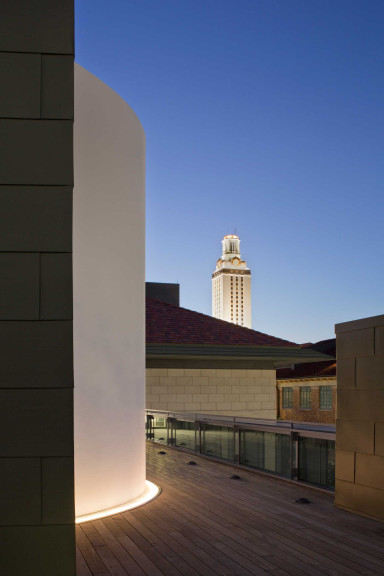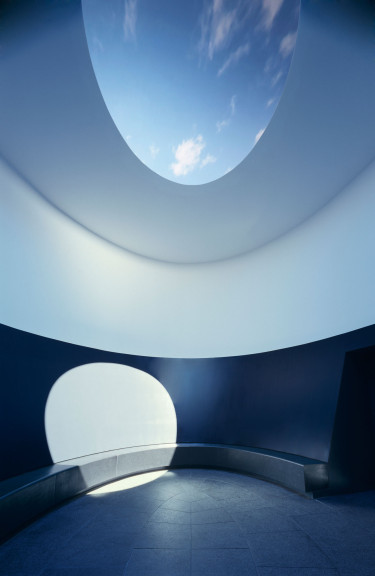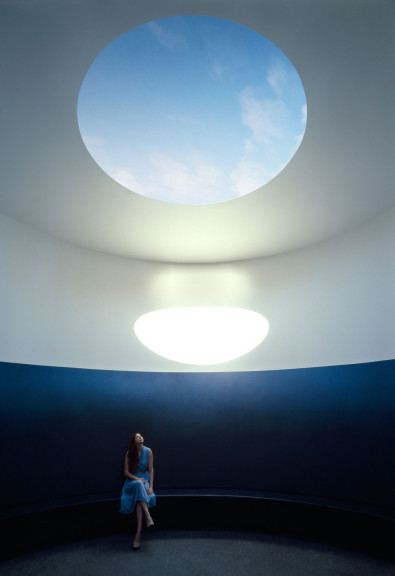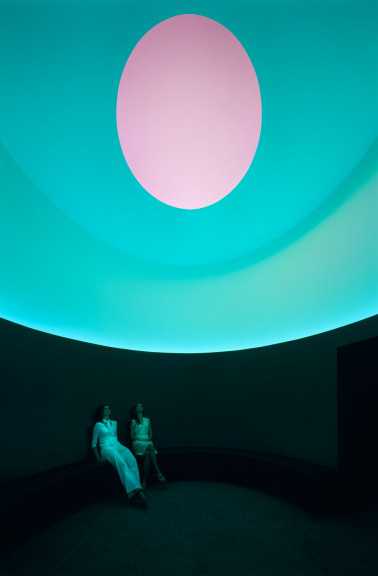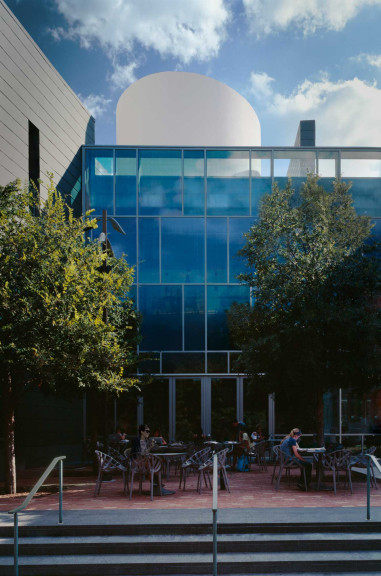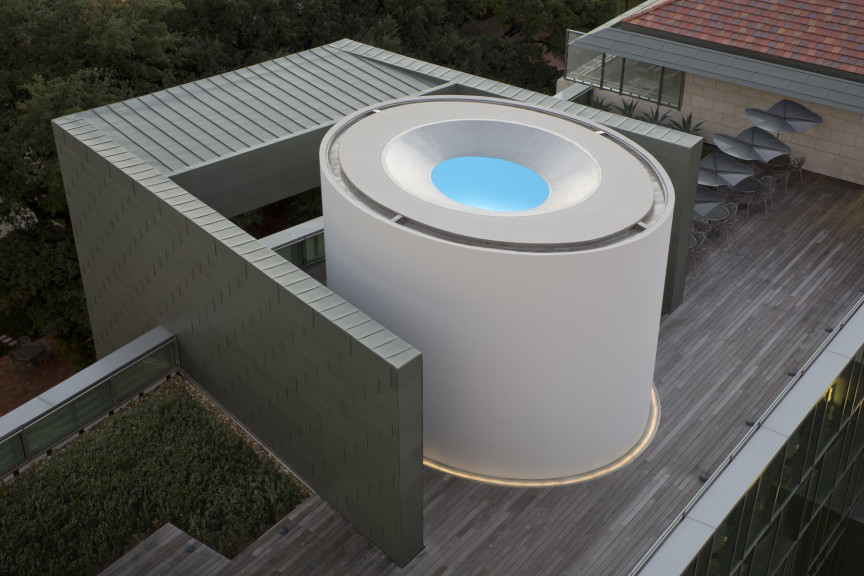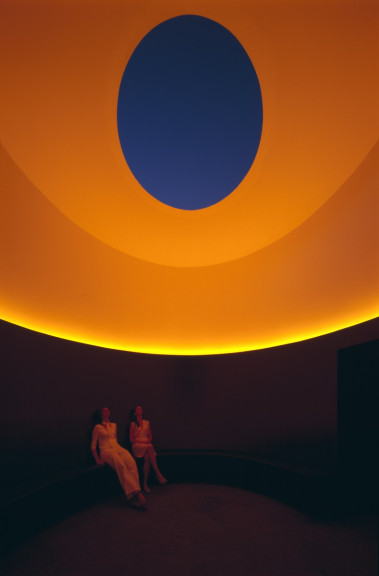The Color Inside
James Turrell
224 × 348 × 276 inches
Photography not permitted
Commission, Landmarks, The University of Texas at Austin, 2013
Advance reservations recommended: www.turrell.utexas.edu
GPS: 30.284792, -97.736327
James Turrell’s artistic medium is light—not paintings that depict light, nor sculptures that incorporate light, but simply light itself. His art offers viewers the opportunity to have unique and intimate experiences with light and to appreciate its transcendent power. Whether through projections, printmaking, or site-specific installations, Turrell’s work is influenced by Quaker simplicity and the practice of going inside to greet the light of revelation.
In the 1960s, Turrell began to experiment with light projections and a variety of installations in which light from the outside penetrated inside, enabling viewers to perceive color within darkened interiors. In some, he cut away parts of the walls to reveal the sky. These cuts evolved into Skyspaces, rooms with sharp-edged apertures in the ceiling that seem to bring the sky down through the opening, almost within reach.
The Color Inside is Turrell’s eighty-fourth Skyspace. Like many others, it is a destination, located on the rooftop of the William C. Powers, Jr. Student Activity Center. Though Turrell’s architectural spaces are reduced to the most essential elements, they retain a simple elegance that makes them particularly enticing. The Color Inside is distinctive for its intimate proportions, elegant palette, lyrical lines, and brilliant washes of color that can be experienced during specialized light sequences at sunrise and sunset, causing the sky to appear in unimaginable hues. Also available for observation during the day, the Skyspace offers a quiet, contemplative space for the campus community and visitors.
In naming The Color Inside, Turrell said, “I was thinking about what you see inside, and inside the sky, and what the sky holds within it that we don’t see the possibility of in our regular life.” The space he created encourages the kind of quiet reflection that cultivates attention. Turrell reminds us that not only does light reveal what is around us but it also makes known that which is within us.
To make a reservation to visit The Color Inside, visit the James Turrell website.
LEARNING AT HOME WITH LANDMARKS
Bring the Landmarks collection into your home-learning environment. Check out how you can engage with this work by browsing the learning resources featured on this page:
- View Photo Gallery - Click on the arrows on the sides of the image above to to view images of the work. Spend time on each photo and examine details carefully as if you were with the work in person.
- Play Audio Guide - Select “Play Audio Guide” in the upper right corner to hear a short audio guide about the art and gain a deeper understanding of its meaning.
- View Videos - Select “View Videos” to watch a 3-minute video with the artist and to understand their process.
- Activity Guides - Choose the activity guide below best suited for young learners in your home.
Still have questions or want to share your Learning at Home with Landmarks experience with us? Keep the conversation going by tagging Landmarks on social media.
ACTIVITY GUIDES
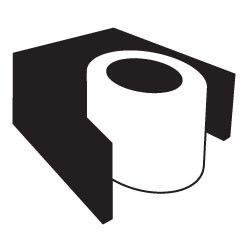
The Color Inside
James Turrell
Subject: Color
Activity: Experiment with primary colors to create new colors
Materials: Paper; red, yellow, and blue pencils or crayons
Vocabulary: Primary colors, spectrum
Light program visit: Color is one of the basic elements of art. Using only the three primary colors an artist can create a limitless spectrum of colors. James Turrell uses colorful light to change the way we see. In the Skyspace, colored lights shine on the walls to change the way our eyes see the color of the sky through the opening in the roof.
Daytime visit: If you visit the Skyspace during the day and are not able to see the colored lights, think about the way the opening in the roof changes how you see the sky. Many artists use paint or clay to create works of art. James Turrell uses light in his art. In the Skyspace there is an opening in the roof that frames the sky and lets natural light into the space.
Light program visit:
What colors do you see in the Skyspace?
How do the different colors make you feel?
What else do you see when you look up?
Do you see birds or shapes in the clouds?
Daytime visit:
What do you see when looking through the opening in the roof?
How does it make you feel to be in a room where you can see the sky?
What else do you see when you look up?
Do you see birds or shapes in the clouds?
Light program visit:
Draw three solid circles, one red, one yellow, and one blue. Color over each circle with a different color, like red over yellow. What new colors do you see? See how many new colors you can create using the primary colors.
Daytime visit:
Draw a circle on a piece of paper. Cut out the circle using scissors. Hold the paper up to the sky and observe how the sky changes by looking through the circle.
Primary colors – red, yellow, and blue, which can be mixed together to make all other colors
Spectrum – a variety of colors, arranged in order as seen in a rainbow
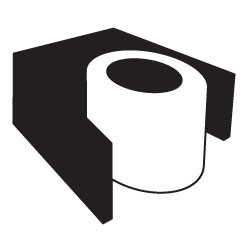
The Color Inside
James Turrell
Subject: Light
Activity: Write a poem inspired by the Skyspace
Materials: Paper, writing utensil
Vocabulary: Medium, optical illusion, abstract
James Turrell uses light as his artistic medium the same way a sculptor uses clay to express their ideas. In the Skyspace he uses lights to color the walls during sunrise and sunset. The light program changes the way our eyes see the natural skylight coming through the opening in the roof, creating an optical illusion. During the day the shifting sky and changing natural light activates the space in new ways.
One of James Turrell’s favorite hobbies is to fly planes. He is inspired by the different light he can see while in the sky and often says, “My airplane is my studio.” Using light to call attention to the way we see, Turrell creates abstract works of art.
How does the sky look when you are in a plane compared to on the ground?
How does changing natural light affect your mood?
How do you feel when it is sunny compared to when it is cloudy or dark?
How do we use light to change our mood?
Think about lights we use during holidays or celebrations.
Write a Haiku poem inspired by light in the Skyspace. Describe the light you see in the Skyspace and the emotions it makes you feel. A Haiku is a short, three-line poem consisting of 17 syllables, as broken down below.
Line 1: 5 syllables
Line 2: 7 syllables
Line 3: 5 syllables
Medium – the material used by an artist such as paint or clay
Optical illusion – a trick that makes one see something that is not actually as it seems
Abstract – art that is not realistic and uses shapes, forms, colors, and textures
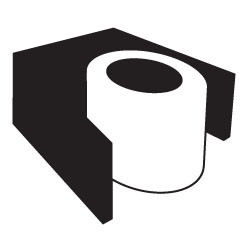
The Color Inside
James Turrell
Subject: Spirituality in art
Activity: Reflect on spiritual works of art through writing
Materials: Paper, pencil
Vocabulary: Abstract, perception, Quaker
James Turrell is an artist whose medium is light. He studied perceptual psychology and art in college and also has interests in aviation, geometry, and astronomy. Sometimes disorienting, his works heighten our perception by using a combination of natural and artificial light. Rooted in the traditions of his Quaker upbringing, Turrell invites visitors to “go inside and greet the light.”
Turrell is well known for his Skyspaces—enclosures that viewers can enter, sit in, and look up to observe the sky through an opening in the ceiling called an oculus. Though the Skyspace is not affiliated with any religion, it serves as a quiet, contemplative place for people to gather, similar to a church or other sacred space.
What makes you feel spiritual?
What makes a place feel spiritual?
What are other examples of works of art that deal with spirituality you have seen?
How do other artists address spirituality in their art?
Option 1: Write about your experience visiting the Skyspace or another experience you’ve had with a work of art that relates to spirituality. Identify specific elements of the art that makes you feel spiritual and explain why.
Option 2: Sketch a design for a space that would inspire your spirituality. Write about why you included specific elements of the design.
Abstract – art that is not realistic and uses shapes, forms, colors, and textures
Perception – the way we become aware of things through our senses
Quaker – a religious group devoted to peaceful principles
Oculus – circular opening in a ceiling or wall
MORE INFORMATION
James Turrell’s artistic medium is light—not paintings that depict light, nor sculpture that incorporates light, but simply light itself. Turrell taps into the light that greets us when we flip an electrical switch or turn on a television, the light from headlights and neon signs all around us at night, the light that each day rises in the east and sets in the west, and the light that glimmers in faraway stars. He is particularly gifted at offering us the opportunity to have a unique and intimate experience with light and to appreciate its transcendent power.
Just where does that transcendence lead us? Words like “grace,” “revelation,” “rapture,” “numinous,” “primordial,” “empyrean,” and “sublime” have all been applied to Turrell’s work. As the grandness of such words implies, Turrell’s work explores our connection to the universe. He takes us to an intense and lofty realm in a confoundingly simple way: he allows us to see ourselves seeing.
Turrell was born in 1943 in Los Angeles, California. He received a BA in psychology from Pomona College in 1965, and during the 1960s he was linked with a number of Southern Californian artists who were exploring light and perception. These “light and space” artists were offered an opportunity to pursue ambitious ideas when the Los Angeles County Museum of Art launched an art and technology program that paired artists with preeminent scientists. Along with artist Robert Irwin, Turrell collaborated with Dr. Edward Wortz, a perceptual psychologist at Garrett Aerospace Corporation. At the time, Dr. Wortz was investigating the perceptual consequences of space travel for NASA. Though nothing concrete materialized from their collaboration, Turrell, who had studied perceptual psychology in school, emerged with a refined mission and a set of ideas that he has been exploring ever since.
Turrell received an MA in art from Claremont Graduate University in 1973. His work is often linked with that of Minimalist artists, and it was in graduate school that he studied with John McCracken and Tony DeLap, who, like Donald Judd and Robert Morris, were engaged in making Minimalist sculpture. Those artists, however, were dealing with substantive and unyielding mass, whereas Turrell’s perceptual volumes are immaterial. But, Turrell would remain an admirer of the direct style and clarity of Minimalism.
Turrell’s parents were Quakers, and his work is influenced by the Quaker practice of going inside to greet the light of revelation as well as the belief that spirituality flourishes in simple settings. Plainness and economy of means, along with a straightforward, strict presentation of the sublime, are considered Quaker virtues—characteristics that go hand in hand with Turrell’s work, which is pared down, direct, and quiet.
Turrell’s father was a trained aeronautical engineer and educator, and James himself became a pilot at the early age of sixteen. His knowledge of aeronautics and his multifaceted experiences as a pilot also inform his work, leading to an engagement with natural light, sunrises, sunsets, and even the stars and planets. For years he flew around the American west in search of a natural site that would allow him to pursue the lifelong dream of creating a multichambered naked-eye observatory. He found such a site in 1977, when he purchased the extinct volcanic Roden Crater in Flagstaff, Arizona. Two years later, he moved to Flagstaff, where he currently practices his art, works on the Roden Crater, and runs a cattle ranch on the property.
Turrell’s interest in perception and working with light has led to the creation of a series of distinct but interconnected installation works. He developed the ideas for most of those works early in his career, and he continues to revisit some of them from time to time, creating new works in a given series. More often than not, the installations require an investment of time on the part of the viewer, as they are best experienced after the eyes have had time to adjust to different light levels and environments.
During the mid-1960s, Turrell rented the former Mendota Hotel in Santa Monica, California, turning it into a studio and exhibition space. He closed off entire rooms to create a variety of installations, some of which allowed light from the outside to venture inside via room-sized pinhole cameras. With those works, Turrell was able to “apprehend the light so as to be physically present within the space” (Govan and Kim, eds, James Turrell, 43).
During that time, Turrell also began a series of “projection pieces” in which he uses a modified halogen projector to create “three-dimensional forms” (for example, a pyramid or cube) that appear to float in front of walls. He uses a similar technique for the “shallow spaces” (for example, The Light Inside, Museum of Fine Arts, Houston, 1999), except that an actual space, rather than a hypothetical one, is activated. In those works, the walls seem to float as the physical architecture enables light to emanate from a cavity. In the “wedgeworks,” Turrell uses florescent light sources from behind partition walls to create the appearance of a transparent light screen. Rooms filled with a soft, misty light sometimes have vibrant color combinations that are heightened as your eyes adjust to the darkened rooms. “Veils” are a variation on the wedgeworks in which the seemingly magical light emanates from above rather than from the side. In the “dark spaces,” viewers sit in an unlit chamber while their eyes adjust and seek color within the darkness. As Turrell describes the experience: It is similar to the act of meditating, but in one of his dark spaces, the viewer does so with their eyes open and while actively seeking. The “Ganzfeld pieces” are similarly disorienting in that the viewer is surrounded by light but looks into an uncertain space with no information or clues as to where it goes or ends. Turrell has created analogous conditions on a smaller scale in his “perceptual cells“—freestanding structures similar to telephone booths that allow you to enter and experience a Ganzfeld or complete field.
The space division constructions, which Turrell began in 1976, present the viewer with a different kind of experience. Upon entering a dark room, one sees what appears to be a two-dimensional canvas of light. But as the eyes adjust, the canvas of luminous color actually turns out to be an aperture or hole cut out of a vertical wall, revealing an indeterminate space beyond that is filled with light. The colorful light has an almost tactile quality that seems to fill the space—people have been known to reach out in an attempt to touch the light. Turrell has also created space division constructions for use as theatrical sets in which dancers wearing special costumes and make-up move within the light.
In the Mendota Hotel, Turrell did pioneering works in which he cut away parts of the walls to reveal the sky. The “structural cuts” would later appear as lunettes, skylights, and other architectural elements in settings specifically designed to house them. The cuts in turn lead to what have become known as “Skyspaces,” rooms with sharp-edged apertures in the ceiling that open to the sky. The enclosed spaces are empty save for benches placed along the walls. Just as the space division constructions appear to fill a room with light right up to a two-dimensional plane, the skypaces seem to bring the sky down to the opening in the ceiling, almost within reach.
Turrell also has engaged the heavens with a series of “landworks.” The works range from a relatively simple craterlike bowl in which the viewer can experience celestial vaulting (the perceptual phenomena of the sky bending around to surround you as if you are in a bubble) to the lifelong project of almost unimaginable ambition, Roden Crater. An observatory created in an extinct volcano, Roden is approximately seventy-eight stories tall. It will ultimately be filled with tunnels and chambers from which to observe various solar, lunar, and celestial phenomena. Phase I is complete and work has begun on Phases II and III. The chambers will allow viewers to experience a variety of events from a setting that is respectful of and steeped in geologic time. No telescopes are required, as it is an observatory for the naked eye. Like Turrell’s Skyspaces, Roden Crater allows the viewer to connect with the sky above, but it goes even further by offering engagement with stars and planets that are light years away. Because he is an artist working in the American West, many consider Roden Crater to be the climax of the earthwork movement. However, unlike earthworks by artists like Michael Heizer and Robert Smithson, Turrell’s alteration of the terrain is barely perceptible, and while many of those artists’ works are intentionally ephemeral, Turrell’s act of forging a direct and unforgettable link through the sky to the greater universe beyond is timeless.
In many ways, it is a fool’s errand to list or capture James Turrell’s output as an artist. In addition to the above-mentioned installation works, he has also produced suites of prints, holograms, architectural models, photographs, and even a line of ceramics— Lapsed Quaker Ware —that are inspired by Josiah Wedgewood. It is no wonder that he has received prestigious awards from the Guggenheim, Lannan, and MacArthur foundations.
The Color Inside, 2013
Before the new Student Activity Center was designed for The University of Texas at Austin, the student body was surveyed as to their preferences for the center. A place for quiet reflection was on that wish list, and James Turrell’s The Color Inside is just such a place.
Turrell sited the work on the rooftop, just within the campus height restrictions so that nothing will obstruct its view. As such, it is somewhat hidden from visitors who enter the center from the street; thus, one must make a pilgrimage of sorts in order to find it. It is a strategy Turrell has engaged many times before: by making his works difficult to find, anticipation is heightened, enhancing the overall experience of the work upon its discovery.
Turrell’s second Skyspace is hidden in an upper-floor classroom of what was once P.S. 1 in Long Island, New York (it is now a part of the Museum of Modern Art campus). For Meeting (1978), the viewer ascends multiple staircases and walks down long corridors filled with classroom doors to a particular door that opens to the sky. In yet another Skyspace, Heavy Water (1991), in Poitiers, France, the magic of the work is only revealed to those who don a 1920’s-style black-and-white striped bathing suit, dive into a pool, and swim under a wall to enter a space in which light appears to come out of the water.
At the Student Activity Center, elevators or stairs take visitors to a corridor that leads to The Color Inside. At the end of a corridor, a glass door opens onto a rooftop garden. As a boardwalk leads you through the garden, you become aware of a graceful and seductively curvalinear building resting within the garden. Only those willing to seek the entrance to the building will find the Skyspace. A thin band of glass tile rings the base of the building, and as you follow it around, an open vestibule presents itself. Stepping over the glass tile into the space is similar to crossing a liminal threshold: you are leaving the center and entering a different kind of place—there, in the midst of a dense, urban environment is a seductively gentle, open, and airy chamber in which to lose oneself for a time.
While Turrell is known for reducing his architectural spaces down to the fundamentals, there is always a simple elegance that makes them particularly inviting. In The Color Inside, he created an elliptical space with honed black basalt seating (with radiant heat) and tiled flooring, the design of which reminds one of an ancient fossil. Like two hands coming together to embrace you, the gentle curves of the elliptical building invite you to come in and sit. Above is an elliptically shaped oculus. In other Skyspaces, Turrell created circular, square, and rectangular openings, and as his architectural models and realized Skyspaces reveal, he is interested in a variety of cultures and approaches to spirituality. For example, the Pantheon in Rome, which was built for the gods, is perhaps the best-known architectural structure with an oculus. As viewed through the oculus in the lofty dome of the Pantheon, the heavens seem remote and faraway, whereas Turrell’s Skyspaces bring the sky down to us. And in The Color Inside, the more gentle and lyrical lines of the ellipse and the human scale of the building somehow make our meditative departure—our spiritual journey—that much more possible.
The Skyspace can be experienced and enjoyed at any time of day, but sunrise and sunset are the most dramatic times, when the sky itself undergoes conspicuous changes and when the art can be experiences as Turrell intends. It is best to settle in before the sky begins to change and remain until the changes are complete. During those times, Turrell enhances the experience by providing a specialized light program within the space (hidden above the seating). In a Turrell Skyspace, the sky reveals itself in an altogether new guise. You forget that you are looking at the sky as the color changes unimaginably, becoming rich, deep, and intense. Reality might break in occasionally in the form of a bird flying overhead or a cloud floating by, but your reverie quickly engulfs you again. As the sky gets darker, it becomes velvety in a way that invites you to reach up and touch. And as you sit quietly, you discover what it is to see yourself seeing. It is wondrous whether you experience it alone or together with friends. Such a work truly needs to be experienced first hand; a photographic reproduction cannot adequately convey the perceptual awakenings that occur during such a viewing.
Turrell’s seemingly magical illusions are created with familiar materials—here by cutting a hole in the ceiling and adding some LED lights. But in Turrell’s hands, such simple gestures are so ingeniously and precisely presented that they allow us to see the sky as we have never seen it before. While through their work many contemporary artists’ seek to be a part of the time and moment in which they are creating, Turrell aims for a purity of form and timelessness. Because the evolution of human intelligence is primarily based on information that we have gathered through vision, light has come to mean illumination and enlightenment, or a possession of the mind. Turrell understands that premise and also that not only does light reveal what is around us, but it also makes known that which is inside us.
Lynn Herbert is a former senior curator at the Contemporary Arts Museum, Houston (CAMH). She organized the exhibition James Turrell: Spirit and Light and has written extensively about his work.
Daniel Birnbaum, Georges Didi-Huberman, Michael Rotondi, and Paul Virilio. James Turrell: The other horizon. Vienna: Austrian Museum of Applied Arts, 1999.
Julia Brown, ed. Occluded Front: James Turrell. Los Angeles: Fellows of Contemporary Art, Los Angeles, and Lapis Press, 1985.
Govan, Michael, and Christine Kim, eds._ James Turrell: A Retrospective_. Los Angeles: Los Angeles County Museum of Art and DelMonico Books • Prestel, 2013.
Herbert, Lynn M., John H. Lienhard, J. Pittman McGehee, and Terence Riley. James Turrell: Spirit and Light. Houston: Contemporary Arts Museum, Houston, 1998.
Hylton, Wil S. “How James Turrell Knocked the Art World Off Its Feet.” New York Times Magazine, 13 June 2013.http://www.nytimes.com/2013/06/16/magazine/how-james-turrell-knocked-th…;.
Torres, Anna Maria. James Turrell. Valencia: Institut Valenciá d’Art Modern, 2004.
Landmarks commissioned artist James Turrell to create a Skyspace for the rooftop of the William C. Powers, Jr. Student Activity Center at 22nd Street and Speedway. High above the center of the busy university campus, the Skyspace provides a quiet and airy chamber for contemplation.
The William C. Powers, Jr. Student Activity Center was designed by Overland Partners architects who also served as lead architects for the Skyspace. The green roofs that surround the Skyspace were initially designed by Walter Hood and implemented by Bender Wells Clark.
Funding for the Skyspace was provided by the capital improvement project that included the William C. Powers, Jr. Student Activity Center and the College of Liberal Arts. Numerous individuals lent their support to this project and Landmarks would like to give special thanks to the following:
Leadership
Andrée Bober and Landmarks
Pat Clubb and University Operations
Douglas Dempster and the College of Fine Arts
Randy Diehl and the College of Liberal Arts
Landmarks Advisory Committee
William Powers and the Office of the President
Bob Rawski and the Office of Facilities Planning and Construction
David Rea and the Office of Campus Planning
Andy Smith and University Unions
Bill Throop and Project Management and Construction Services
Samuel Wilson, Sharon Wood, and the Faculty Building Advisory Committee
Project Team
Rick Archer, Overland Partners Architects
Andy Adkins, Office of Facilities Planning and Construction
Andrée Bober, curator and director, Landmarks
Hiram Butler, Hiram Butler Gallery
Paul Cornell, Office of Facilities Planning and Construction
Serena Hayden, SpawGlass
Eric Kennedy, SpawGlass
James Lancaster, Overland Partners Architects
Dan McClure, SpawGlass
Nisa Mason, project manager, Landmarks
Ryan Pike, James Turrell Studio
Michael Uyeda, Office of Facilities Planning and Construction
Special Thanks
Grant Barger, College of Liberal Arts
Margaret Burke, education, Landmarks
Larry Clark and Bender Wells Clark
Fran Gale, School of Architecture
Funny Garbage, project website
Bill Haddad, technician, Landmarks
Lynn Herbert, curatorial contributor
Harvey Hix, poet
Walter Hood and Hood Studio
Philip Just, Go Design
Steve Kraal, Facility Services
Cody Kukulski, James Turrell Studio
Crystal King, University Unions
James Lancaster, Overland Partners
Tony Lee, James Turrell Studio
Steven Leslie, Office of the Vice President and Provost
Joel Love, composer
Mike Miller, Facility Services
Sally Moore, Facility Services
Beth Palazzolo, administrative coordination, University Operations
Nick Parras, William C. Powers, Jr. Student Activity Center
Matthew Schreiber, James Turrell Studio
Patrick Sheehy, Vault Fine Art Services
Stephanie Taparauskas, development, Landmarks
Joe Tenbarge, College of Liberal Arts
Jennalie Travis, development, Landmarks
Kyung Turrell, James Turrell Studio
Rhonda Wheldon, University Operations
Catherine Williams, Silver Lining Art Conservation
Misa Yamamoto, College of Fine Arts
Words to Wordlessness
H. L. Hix
North: aurora
Seeing that sees
sees not some thing
not the else concealed
not the invisible the god.
Naught but itself sees
sight seeing seeing sight.
East: terminator
Why think the sun’s sinking
casts up earth’s shadow
into not-yet-quite-night?
Why not say that same shadow
sends down the shamed sun
into never-was-quite-day?
South: radio-bright bodies
Deep space does speak
quasar calls to quasar
past what spectrum we see
outside what storylines we learn.
A tune. Attune.
Over here. Overhear.
West: twilight arch
As silence absents
not sound but self
so does darkness lessen
loss not luminescence.
Don’t ask this light
which world sent it us


